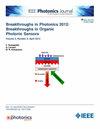High Ambient Contrast Ratio and Efficiency LED Display Devices Utilizing Inverted Packaging Structure
IF 2.1
4区 工程技术
Q3 ENGINEERING, ELECTRICAL & ELECTRONIC
引用次数: 0
Abstract
Highly light-absorbed encapsulation is generally used to eliminate the ambient light for light-emitting diode (LED) display devices, it is challenging to simultaneously achieve a high ambient contrast ratio (ACR) and high light output efficiency (LOE). To solve this problem, we propose an inverted packaging structure for LED display devices. The LED chips’ emitting surface is mounted on the transparent carrier board (TCB) while the backside is packaged by the composite encapsulation, causing that the substrate is inverted to the topside of devices. As a result, the chips can emit light directly from the TCB and avoid the absorption loss of the encapsulation, leading to the high ACR and LOE performances. Compared to traditional devices, the inverted device showed an average increase of over 800% in luminous flux (LF) and LOE, and an average increase of over 390% in ACR. Additionally, the devices exhibited excellent soldering performance, corrosion resistance, airtightness, and thermal stability. This novel device overcomes the bottleneck of achieving both high ACR and high LOE, providing new insights for the development of LED display technology. Future work can further optimize the structure and materials of the TCB and composite encapsulation to enhance device performance.求助全文
约1分钟内获得全文
求助全文
来源期刊

IEEE Photonics Journal
ENGINEERING, ELECTRICAL & ELECTRONIC-OPTICS
CiteScore
4.50
自引率
8.30%
发文量
489
审稿时长
1.4 months
期刊介绍:
Breakthroughs in the generation of light and in its control and utilization have given rise to the field of Photonics, a rapidly expanding area of science and technology with major technological and economic impact. Photonics integrates quantum electronics and optics to accelerate progress in the generation of novel photon sources and in their utilization in emerging applications at the micro and nano scales spanning from the far-infrared/THz to the x-ray region of the electromagnetic spectrum. IEEE Photonics Journal is an online-only journal dedicated to the rapid disclosure of top-quality peer-reviewed research at the forefront of all areas of photonics. Contributions addressing issues ranging from fundamental understanding to emerging technologies and applications are within the scope of the Journal. The Journal includes topics in: Photon sources from far infrared to X-rays, Photonics materials and engineered photonic structures, Integrated optics and optoelectronic, Ultrafast, attosecond, high field and short wavelength photonics, Biophotonics, including DNA photonics, Nanophotonics, Magnetophotonics, Fundamentals of light propagation and interaction; nonlinear effects, Optical data storage, Fiber optics and optical communications devices, systems, and technologies, Micro Opto Electro Mechanical Systems (MOEMS), Microwave photonics, Optical Sensors.
 求助内容:
求助内容: 应助结果提醒方式:
应助结果提醒方式:


